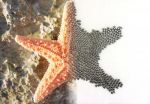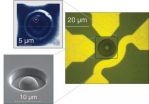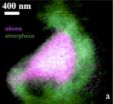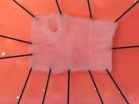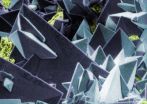(Press-News.org) Bacteria's ability to destroy viruses has long puzzled scientists, but researchers at the Johns Hopkins Bloomberg School of Public Health say they now have a clear picture of the bacterial immune system and say its unique shape is likely why bacteria can so quickly recognize and destroy their assailants.
The researchers drew what they say is the first-ever picture of the molecular machinery, known as Cascade, which stands guard inside bacterial cells. To their surprise, they found it contains a two-strand, unencumbered structure that resembles a ladder, freeing it to do its work faster than a standard double-helix would allow.
The findings, published online Aug. 14 in the journal Science, may also provide clues about the spread of antibiotic resistance, which occurs when bacteria adapt to the point where antibiotics no longer work in people who need them to treat infections, since similar processes are in play. The World Health Organization (WHO) considers antibiotic resistance a major threat to public health around the world.
"If you understand what something looks like, you can figure out what it does," says study leader Scott Bailey, PhD, an associate professor in the Bloomberg School's Department of Biochemistry and Molecular Biology. "And here we found a structure that nobody's ever seen before, a structure that could explain why Cascade is so good at what it does."
For their study, Bailey and his colleagues used something called X-ray crystallography to draw the picture of Cascade, a key component of bacteria's sophisticated immune system known as CRISPR, an acronym for Clustered Regularly Interspaced Short Palindromic Repeats. Cascade uses the information housed in sequences of RNA as shorthand to identify foreign invaders and kill them.
Much of the human immune system is well understood, but until recently scientists didn't realize the level of complexity associated with the immune system of single-cell life forms, including bacteria. Scientists first identified CRISPR several years ago when trying to understand why bacterial cultures used to make yogurt succumbed to viral infections. Researchers subsequently discovered they could harness the CRISPR bacterial immune system to edit DNA and repair damaged genes. One group, for example, was able to remove viral DNA from human cells infected with HIV.
Bailey's work is focused on how Cascade is able to help bacteria fight off viruses called bacteriophages. The Cascade system uses short strands of bacterial RNA to scan the bacteriophage DNA to see if it is foreign or self. If foreign, the cell launches an attack that chews up the invading bacteriophage.
To "see" how this happens, Bailey and his team converted Cascade into a crystalized form. Technicians at the National Synchrotron Light Source at Brookhaven National Laboratory in Upton, NY, and the Stanford Synchrotron Radiation Lightsource then trained high-powered X-rays on the crystals. The X-rays provided computational data to the Bloomberg School scientists allowing them to draw Cascade, an 11-protein machine that only operates if each part is in perfect working order.
What they saw was unexpected. Instead of the RNA and DNA wrapping around each other to form what is known as a double-helix structure, in Cascade the DNA and RNA are more like parallel lines, forming something of a ladder. Bailey says that if RNA had to wrap itself around DNA to recognize an invader – and then unwrap itself to look at the next strand – the process would take too much time to ward off infection. With a ladder structure, RNA can quickly scan DNA.
In the new study, Bailey says his team determined that the RNA scans the DNA in a manner similar to how humans scan text for a key word. They break long stretches of characters into smaller bite-sized segments, much like words themselves, so they can be spotted more easily.
Since the CRISPR-Cas system naturally acts as a barrier to the exchange of genetic information between bacteria and bacteriophages, its function can offer clues to how antibiotic resistance develops and ideas for how to keep it from happening.
"We're finding more pieces to the puzzle," Bailey says. "This gives us a better understanding of how these machines find their targets, which may help us harness the CRISPR system as a tool for therapy or manipulation of DNA in a lab setting. And it all started when someone wanted to make yogurt more cheaply."
INFORMATION:
"Crystal structure of a CRISPR RNA-guided surveillance complex bound to a ssDNA target," was written by Sabin Mulepati, Annie Heroux and Scott Bailey.
This work was funded by a grant from the National Institute of Health's National Institute of General Medical Sciences (GM097330).
Harnessing the power of bacteria's sophisticated immune system
Researchers now better understand how bacteria can so quickly protect itself from harm, could help unlock clues about antibiotic resistance
2014-08-14
ELSE PRESS RELEASES FROM THIS DATE:
Message to parents: Babies don't 'start from scratch'
2014-08-14
There's now overwhelming evidence that a child's future health is influenced by more than just their parents' genetic material, and that children born of unhealthy parents will already be pre-programmed for greater risk of poor health, according to University of Adelaide researchers.
In a feature paper called "Parenting from before conception" published in today's issue of the top international journal Science, researchers at the University's Robinson Research Institute say environmental factors prior to conception have more influence on the child's future than previously ...
A self-organizing thousand-robot swarm
2014-08-14
Cambridge, Mass. – August 14, 2014 – The first thousand-robot flash mob has assembled at Harvard University.
"Form a sea star shape," directs a computer scientist, sending the command to 1,024 little bots simultaneously via an infrared light. The robots begin to blink at one another and then gradually arrange themselves into a five-pointed star. "Now form the letter K."
The 'K' stands for Kilobots, the name given to these extremely simple robots, each just a few centimeters across, standing on three pin-like legs. Instead of one highly-complex robot, a "kilo" of robots ...
Molecular engineers record an electron's quantum behavior
2014-08-14
A team of researchers led by the University of Chicago has developed a technique to record the quantum mechanical behavior of an individual electron contained within a nanoscale defect in diamond. Their technique uses ultrafast pulses of laser light both to control the defect's entire quantum state and observe how that single electron state changes over time. The work appears in this week's online Science Express and will be published in print later this month in Science.
This research contributes to the emerging science of quantum information processing, which demands ...
Mysteries of space dust revealed
2014-08-14
The first analysis of space dust collected by a special collector onboard NASA's Stardust mission and sent back to Earth for study in 2006 suggests the tiny specks, which likely originated from beyond our solar system, are more complex in composition and structure than previously imagined.
The analysis, completed at a number of facilities including the U.S. Department of Energy's Lawrence Berkeley National Lab (Berkeley Lab) opens a door to studying the origins of the solar system and possibly the origin of life itself.
"Fundamentally, the solar system and everything ...
New Milky Way maps help solve stubborn interstellar material mystery
2014-08-14
An international team of sky scholars, including a key researcher from Johns Hopkins, has produced new maps of the material located between the stars in the Milky Way. The results should move astronomers closer to cracking a stardust puzzle that has vexed them for nearly a century.
The maps and an accompanying journal article appear in the Aug. 15 issue of the journal Science. The researchers say their work demonstrates a new way of uncovering the location and eventually the composition of the interstellar medium—the material found in the vast expanse between star systems ...
CF mucus defect present at birth
2014-08-14
VIDEO:
This is a 3-D reconstruction from time-lapse CT-scans of a CF pig lung. Images show the trachea and bronchi. Colored round dots represent positions of particles that were...
Click here for more information.
Mucus is key to keeping our lungs clean and clear of bacteria, viruses, and other foreign particles that can cause infection and inflammation. When we inhale microbes and dust, they are trapped in the mucus and then swept up and out of the lungs via a process called ...
Potential drug therapy for kidney stones identified in mouse study
2014-08-14
Anyone who has suffered from kidney stones is keenly aware of the lack of drugs to treat the condition, which often causes excruciating pain.
A new mouse study, however, suggests that a class of drugs approved to treat leukemia and epilepsy also may be effective against kidney stones, researchers at Washington University School of Medicine in St. Louis report.
The drugs are histone deacetylase inhibitors, or HDAC inhibitors for short. The researchers found that two of them — Vorinostat and trichostatin A — lower levels of calcium and magnesium in the urine. Both calcium ...
Broader organ sharing won't harm liver transplant recipients
2014-08-14
New research shows that broader sharing of deceased donor livers will not significantly increase cold ischemia time (CIT)—the time the liver is in a cooled state outside the donor suggesting that this is not a barrier to broader sharing of organs. However, findings published in Liver Transplantation, a journal of the American Association for the Study of Liver Diseases and the International Liver Transplantation Society, do indicate that broader sharing of organs will significantly increase the percentage of donor organs that are transported by flying rather than driving. ...
Scientists study 'talking' turtles in Brazilian Amazon
2014-08-14
AUDIO:
These are vocalizations made between adults and hatchlings (individual sounds repeated for the listener's benefit).
Click here for more information.
Turtles are well known for their longevity and protective shells, but it turns out these reptiles use sound to stick together and care for young, according to the Wildlife Conservation Society and other organizations.
Scientists working in the Brazilian Amazon have found that Giant South American river turtles actually ...
Scientists fold RNA origami from a single strand
2014-08-14
RNA origami is a new method for organizing molecules on the nanoscale. Using just a single strand of RNA, many complicated shapes can be fabricated by this technique. Unlike existing methods for folding DNA molecules, RNA origamis are produced by enzymes and they simultaneously fold into pre-designed shapes. These features may allow designer RNA structures to be grown within living cells and used to organize cellular enzymes into biochemical factories. The method, which was developed by researchers from Aarhus University (Denmark) and California Institute of Technology ...
LAST 30 PRESS RELEASES:
Automatic label checking: The missing step in making reliable medical AI
Low daily alcohol intake linked to 50% heightened mouth cancer risk in India
American Meteorological Society announces Rick Spinrad as 2026 President-Elect
Biomass-based carbon capture spotlighted in newly released global climate webinar recording
Illuminating invisible nano pollutants: advanced bioimaging tracks the full journey of emerging nanoscale contaminants in living systems
How does age affect recovery from spinal cord injury?
Novel AI tool offers prognosis for patients with head and neck cancer
Fathers’ microplastic exposure tied to their children’s metabolic problems
Research validates laboratory model for studying high-grade serous ovarian cancer
SIR 2026 delivers transformative breakthroughs in minimally invasive medicine to improve patient care
Stem Cell Reports most downloaded papers of 2025 highlight the breadth and impact of stem cell research
Oxford-led study estimates NHS spends around 3% of its primary and secondary care budget on the health impacts of heat and cold in England
A researcher’s long quest leads to a smart composite breakthrough
Urban wild bees act as “microbial sensors” of city health.
New study finds where you live affects recovery after a hip fracture
Forecasting the impact of fully automated vehicle adoption on US road traffic injuries
Alcohol-related hospitalizations from 2016 to 2022
Semaglutide and hospitalizations in patients with obesity and established cardiovascular disease
Researchers ‘listen in’ to embryo-mother interactions during implantation using a culture system replicating the womb lining
How changing your diet could help save the world
How to make AI truly scalable and reliable for real-time traffic assignment?
Beyond fragmented markets: A new framework for efficient and stable ride-pooling
Can shape priors make road perception more reliable for autonomous driving?
AI tracks nearly 100 years of aging research, revealing key trends and gaps
Innovative techniques enable Italy’s first imaging of individual trapped atoms
KIER successfully develops Korea-made “calibration thermoelectric module” for measuring thermoelectric device performance
Diversifying US Midwest farming for stability and resilience
Emphasizing immigrants’ deservingness shifts attitudes
Japanese eels, climate change, and river temperature
Pusan National University researchers discover faster, smarter heat treatment for lightweight magnesium metals
[Press-News.org] Harnessing the power of bacteria's sophisticated immune systemResearchers now better understand how bacteria can so quickly protect itself from harm, could help unlock clues about antibiotic resistance
